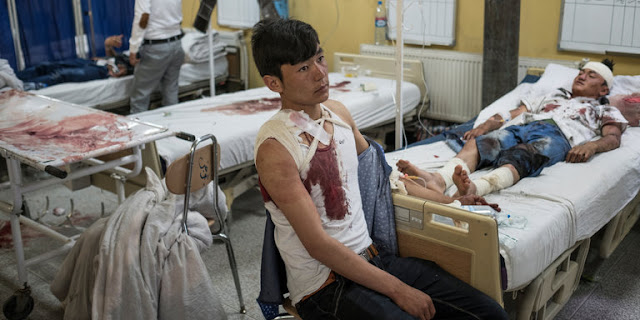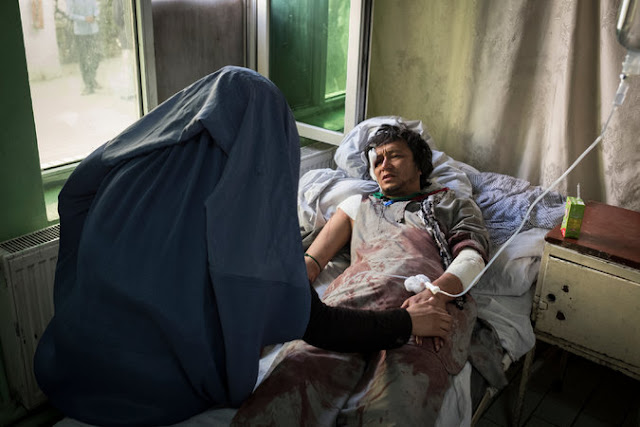ISIS Claims Deadly Bombing at Demonstration in Kabul, Afghanistan
Hospitals treated the many Afghans wounded Saturday when suicide bombers struck a demonstration in Kabul, the capital.
KABUL, Afghanistan — The Islamic State claimed a bombing that left at least 80 people dead Saturday at a peaceful demonstration in the Afghan capital of Kabul, raising fears that the group may be extending its reach beyond the country’s eastern pockets, where it generally operates.
The Afghan Interior Ministry, in a statement, said the attack on thousands of Hazaras, an ethnic minority group staging the protest, had been a suicide mission.
“The attack was carried out by three suicide bombers: The first person carried out a blast, the second one failed at his detonation, and the third terrorist was killed in shooting by the security forces,” the ministry said.
The second assailant was presumed to be at large, a security official said, speaking on the condition of anonymity as he was not authorized to discuss intelligence matters.
At least 231 people at the protest were wounded. The demonstrators had gathered in the west of Kabul to demand that a proposed electricity transmission line be routed through Bamian, a Hazara-dominated province in central Afghanistan.
The Islamic State, in a statement on the group’s Amaq News Agency, claimed the carnage as a “martyrdom attack” on Shiites.
A child injured in an explosion on Saturday in Kabul, Afghanistan. The government reported at least 80 dead and 231 injured.
Officials saw the Islamic State’s first assault on the Afghan capital as retaliation for operations by Afghan ground forces and American airstrikes that have intensified in recent weeks, targeting the group’s stronghold in eastern Nangarhar Province.
Afghan security officials said that while Kabul remained under constant insurgent threat, they had no prior intelligence of a particular threat to the protest. After the attack, officials intercepted information from Islamic State commanders in the Achin district, the group’s base in eastern Afghanistan where villagers have been terrorized for months now, congratulating each other for the carnage, the security official said.
President Ashraf Ghani, appearing on national television to announce a day of mourning, called the bombing a “cowardly attack on the freedoms of our citizens.” In meetings with religious leaders and his security team, he said the attack had been the work of the Islamic State.
Tadamichi Yamamoto, the United Nations envoy to Afghanistan, said the deliberate targeting of a large group of civilians amounted to a war crime.
“This incident is an outrage that cannot be justified,” Mr. Yamamoto said. “It is an attempt to spread terror amongst civilians and stifle the freedoms that Afghans have sacrificed so much to obtain.”
Much of the city had been under lockdown before the protesters came out early Saturday. Mr. Ghani’s government had stacked shipping containers to block routes to the presidential palace in anticipation of the demonstration.
A man who was treated for his wounds after the explosions in Kabul.
The Hazaras have only in the past decade tried to shake off a long history of oppression. The protest leaders said the government remained rife with “systematic bias” against the Hazaras, and had routed the electricity transmission line elsewhere, depriving the central Afghan region not only of electricity but also of the roads and other infrastructure that would come with it.
The government has rejected the claims, saying that the route of the transmission line was decided purely on technical grounds and that Bamian would still be provided with electricity. (Government officials, who said they had increased efforts to address the plight of central Afghanistan in the past two years, consider the protests manipulated by the political opposition.)
A sign printed on a piece of paper and held by an older woman proved hauntingly ominous: “Do not eliminate us,” it read. After the explosion, pictures circulated of the sign covered in spots of blood and lying by the side of the road, next to a small green umbrella and human flesh. The fate of the woman was unclear.
Muhammad Ali, a protester whose clothes were covered in blood, said he had loaded dozens of dead bodies into trucks.
“People were going toward a prayer break when two explosions happened — one near the truck where speeches were given,” Mr. Ali said.
Hundreds of protesters returned to the site after the attack, cordoning off the area with a large Afghan flag they had carried in their march, lowering the cordon only to allow ambulances to pass. When the armored vehicle of a government official approached, angry men chased it away. As tempers flared at the government, protesters also pushed away anti-riot police forces who had provided security earlier in the day.
A man injured in one of the blasts, which targeted a peaceful demonstration by the Hazaras, an ethnic minority group.
Later in the evening, protest leaders argued around a candlelight vigil over whether to bury the dead or display their coffins at a protest in the coming days. The large flag, laid on the ground by then, became a display surface for objects left behind: women’s sneakers, notebooks, backpacks, articles of clothing.
Saturday’s attack was one of the deadliest in the past 15 years on the Hazaras, a largely Shiite group. In December 2011, a suicide bombing in aShiite shrine in Kabul killed at least 63 people, mostly Hazaras.
The emergence of ISIS affiliates in late 2014 and early 2015 in eastern and small areas of southern Afghanistan was seen as a splintering in the Taliban insurgency. Though the new groups engaged in the Islamic State’s cruel style of violence, security officials said they saw little sign of communications with the terror network’s headquarters in Iraq and Syria. Instead, the local groups were mostly former Pakistani and Afghan Taliban who had embraced the new brand of terror from a distance.
Mr. Ghani had declared ISIS affiliates in Afghanistan defeated in March, but the group’s re-emergence forced him to travel to Nangarhar Province just last week and order his commanders to intensify their efforts. Salim Khan Kunduzi, the governor of Nangarhar, said operations against the group were being carried out across several districts.
“We are fighting with our full force,” Mr. Kunduzi said. “The Afghan army, the Afghan Air Forces and commandos are fighting against them.”
Saturday’s attack puts further pressure on Mr. Ghani’s struggling government. Even as it tries to build momentum by introducing reforms, his coalition administration has struggled with infighting and with meeting deadlines to hold parliamentary elections. The protest over the electricity transmission line has only added to the administration’s woes.
“The government stacks containers for its own protection, but cannot provide security to its citizens even when they have multiple security cameras,” said Ahmad Behzad, a protest organizer, pointing to surveillance balloons in the sky.
(Source : nytimes.com)







Post A Comment
No comments :